- Yes! Let’s find out animals’ feelings and the way they show us their emotions
- Do animals have the same feelings of humans?
- Animal feelings and emotional intelligence
- Animals have feelings and they prove it to us all the time
- Science confirms that animals have feelings
- And do dogs have feelings?
- Do cats have feelings?
- Do tortoises have feelings?
- Do fish have feelings?
- Do animals feel pain?
- Animal feelings and evolution
- Do animals fall in love?

Yes! Let’s find out animals’ feelings and the way they show us their emotions
Adorable eyes staring at us, purrs melting our hearts, crazy little tails, joyful twittering and other special behaviors…
Yes, animals have feelings and science increasingly agrees that the emotions they feel go far beyond their survival instinct.
The core of the topic is that we humans interpret the feelings and emotions of animals based on how they behave towards us and towards other animals.
In other words, we gather that animals have feelings because we observe their actions and reactions and draw ’emotional’ conclusions. For example: if the pet runs towards us joyfully and licks us from head to toe, we can only deduce that he is happy, or if we see a little bird taking a bath in a fountain, we can think that he is calm and relaxed. Maybe we observe the hamster running on the wheel, and we smile because for us he is playing and, therefore, he is happy, because he is having a lot of fun.
Or, when we look at the goldfish lightly touching each other in the tank, we think they are celebrating Valentine’s Day.
In all these moments we reflect behaviors belonging to us on our animals, gathering that they are experiencing very specific emotions, such as joy, calm, happiness and even love.
But is it really like that?
Do animals have our same feelings?
And if so, do animals show feelings just like we do?
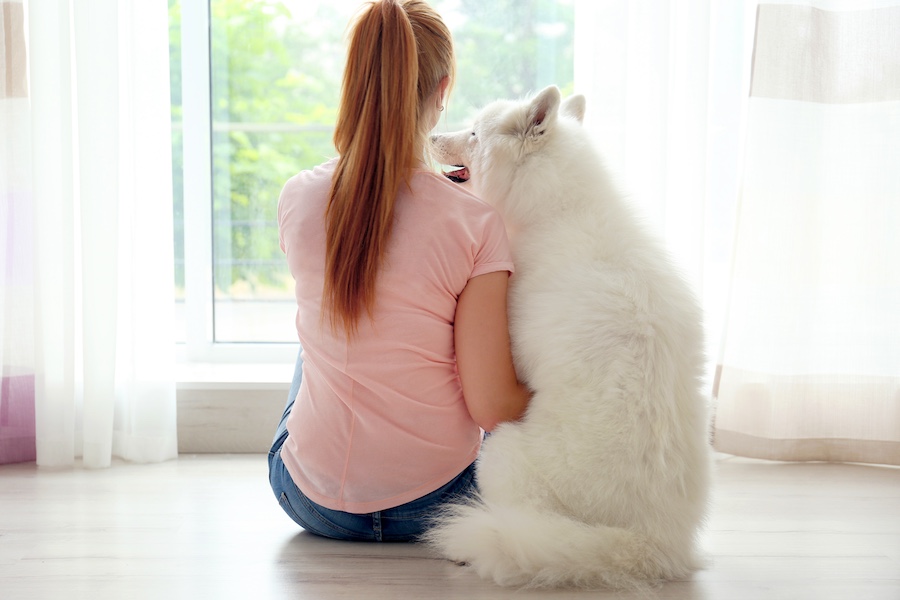
A hug is worth a thousand words.
Do animals have the same feelings of humans?
Joy, euphoria, unconditional love. But also empathy, forgiveness and altruism.
And, vice versa, pain, anger, suffering… Even just by reading one of these moods, we can say that animals have feelings, because we see and perceive it every day with our four-legged hearts companions.
And we can see and understand that animals have feelings even when we watch a film, a TV series or better yet a documentary where they (and their feelings) are the main character.
How can we forget the elegant position of the dog Hachiko waiting for his owner at the train station?
Or Bob the cat’s protective look towards his fragile human friend in the movie “A Street Cat Named Bob”?
We could mention many films or TV series where animals tell us and show us their feelings and emotions and today we are talking about precisely this theme, relying on some scientific researches that have studied and examined in depth whether animals have feelings, in which way and even the intensity.
.
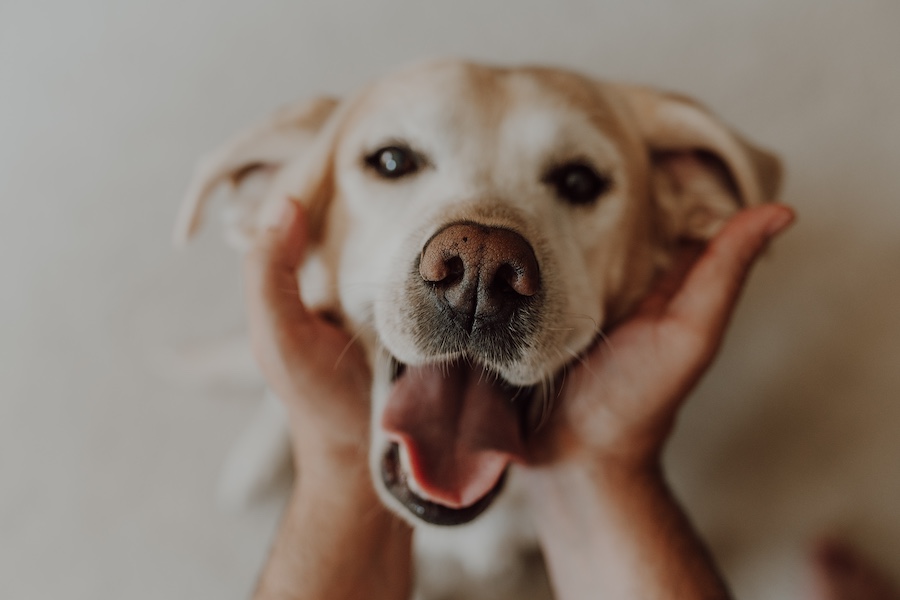
How much affection does this fur baby’s look convey?
Animal feelings and emotional intelligence
We humans are endowed with emotional intelligence, that is, the ability to understand, manage and use our feelings and emotions, to try to communicate in a better way and also to relieve stressful situations.
In this article dedicated to the language of dogs, we saw, in fact, how four-legged hearts inherited from wolves the ability and the will to solve risky situations, therefore their behavior is always aimed at bringing peace and serenity.
This, therefore, is a clear confirmation of the fact that animals have feelings and of the fact that their way of acting is driven by an ’emotional planet’, exactly as happens for us humans.
Animals such as mammals, fish and birds are actually endowed with sensitivity, this means that they use “emotional” information for many purposes. Among these, there are the primary ones, such as finding the food resources they need, defending themselves from predators and protecting their territory, but also establishing social bonds, among themselves and with us humans.
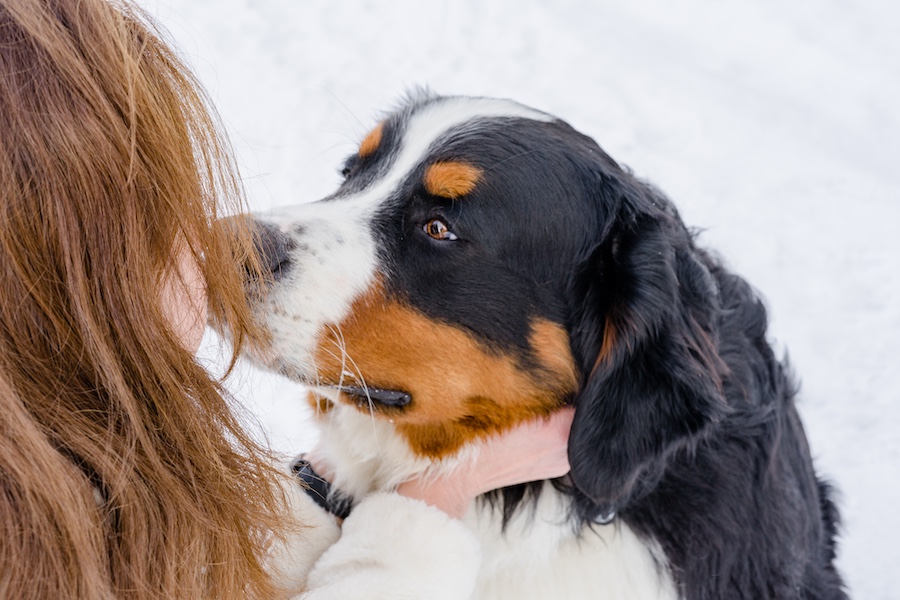
The eyes of this sweet Bernese Mountain Dog show a love declaration.
Animals have feelings and they prove it to us all the time
We humans have different ways of expressing the feelings we experience.
When we laugh out loud we are happy, when we cry we are very sad, when we are nervous we grimace and, in general, our whole body shows the emotions and feelings we are experiencing at that very moment.
But how do animals show their feelings? More or less like us, with their body. Researchers and scholars have in fact learnt to evaluate physiological parameters and also to ‘translate’ animal’s body language.
In fact, everything in an animal shows emotions and feelings, from the dog’s tail that moves rapidly when he is shaken, to that of the cat that takes the shape of a question mark when he is very happy.
These examples are familiar to us, because they belong to the fur homies. But even the monkeys laugh out loud while playing together, because they feel joy, mice make a whistle and jump when they are happy, while horses who feel sad and suffer from loneliness may pull their ears back or repeatedly move their heads left and right.
The fact is that we must remember two fundamental things to find out if animals experience our same feelings.
The first is that their survival instinct is strong and active, and it can produce specific emotions and feelings, linked precisely to the ancestral need to survive.
The second is that there are primary emotions that scholars have defined on the basis of Darwin’s studies that is to say: joy, anger, disgust, sadness, fear and surprise.
Then there are secondary emotions, which are more complex, resulting from primary emotions. These are developed during adulthood. Here are some examples of difficult secondary emotions: shame, envy, jealousy, guilt, offense, anxiety, disappointment and nostalgia, while positive secondary emotions are hope, relief, forgiveness.
The fact that animals have feelings, or experience primary emotions has been studied in depth, and is therefore proven.
Secondary emotions in animals indeed is a topic that has been studied less since it is more complex.
Let’s take a moment to delve deeper into this specific matter of animal feelings.

With cuddles we convey serenity and love to our pets.
Science confirms that animals have feelings
According to the American psychologist Jaak Panksepp, for animals, feelings are like a traffic light linked to their ability to survive.
Negative emotions such as fear or sadness turn on a red light, that is, they warn him that he is entering an area where his survival could be put in danger.
Conversely, positive feelings such as happiness and joy turn on a green light, which indicates that everything is going well.
This explanation is linked to the most primary, ancestral references of animals. Their ability to experience feelings is also confirmed by a study conducted by researchers at Queen’s University of Belfast.
In this case the scholars have defined that animals have positive feelings when they experience success and pessimistic feelings in case of defeat.
What does it mean?
Researchers analyzed studies based on the behavior of animals who are acquiring resources or companions in order to see the role that feelings play in these processes. They therefore defined that the animals’ feelings and their moods play a fundamental role in their decisions.
For example, animals who overcome a conflict prove to be more motivated to compete with their peers in future situations, while defeated animals are more demotivated.
These examples show that animals have complex feelings, but also that feelings play a very important role in their lives, as it happens to us humans!

A paw crossing that seals a great friendship.
And do dogs have feelings?
“Do dogs have feelings?”. “Do they feel sad when we leave home and happy when we return back?”. We wonder how many times we asked ourselves these questions.
Drum roll… the answer is obviously: of course!
And, besides feeling joy, sadness, fear, happiness (in short a range of feelings and emotions that as humans we understand very well) fur babies are also able to recognize what we feel.
An article by Claudia Negrisolo edited by Kodami’s scientific team and validated by Luca Spennacchio, confirms that dogs have feelings and makes reference to a study carried out in 2022 by Paola Valsecchi, Professor of Applied Ethology at the University of Parma.
This study supposes that fur babies are actually able to go beyond primary emotions (joy, sadness, anger, disgust, fear or anxiety, surprise) and also experience complex emotions such as jealousy.
We always start from the idea that feelings in animals, as well as in humans, are an internal universe, through which the world is interpreted, a sort of compass that guides the behavior.
If, for example, we feel fear, we can close ourselves off, choose to escape or even attack. If we are angry we can argue or fight, if we are very happy, we can even experience strong feelings like bursting into tears of joy or hugging someone…
The topic of feelings is very complex and fascinating, after all it involves physical, social and cognitive processes (linked to the process of knowledge and related to behavior). Feelings strongly affect memory as well, both in humans and in our fur babies. When the dog is in a state of fear or agitation, he may struggle to respond to the call of his keeper, while when he is calm and joyful he has a greater predisposition to listen.
That’s why, in modern canophilia, education is built on the psychophysical well-being of the animal, precisely because in most cases problematic or “dangerous” behavior is nothing more than the expression of discomfort.

After this hug, how can we say that dogs don’t have feelings?
A very interesting question is: can we define the feelings of animals and, in this case of dogs, as positive or negative?
Also in this case there are different schools of thought, some define that no emotion is negative in itself, but it can become so when we are unable to manage it.
For example, fear leads to caution, without sadness we could not know joy… therefore every emotion has a meaning and a consequence!
This leads us to think that, knowing that animals have feelings, we also know that they naturally have a personality.
As mentioned, dogs have feelings but they’re also able to understand those of humans. In fact, they manage to build a lasting bond that leads to real harmony.
Among the various research on this topic, the one carried out by the Lincoln University (UK) stands out. In this study, dogs are presented with human and other dogs facial expressions regarding emotions of happiness and joy or fear and aggression, accompanied by individual vocalizations associated with the same emotions. It was noticed that dogs observed much longer the faces whose vocalizations were coherent with the expression. Before this moment this ability was recognized only in humans. These results demonstrated that the dog can recognize bimodal sensory information, but above all that he can differentiate positive and negative emotions in both humans and conspecifics and consequently he acts differently depending on the emotions and reactions of the human who stays with them.
This can scientifically explain what we perhaps already know, that is, if a dog lives with balanced people who show him love, he can, in turn, be a balanced dog who shows love to his pet-mate.
For example, did you ever jump for joy at home and your Fido suddenly went on his hind legs and moved his tail to share your happiness?
Unfortunately, the opposite is true as well.
A study carried out by the Biology department of the University of Naples analyzed the impact of the chemical signals of human emotional states on dog behavior, demonstrating that fur babies activate typical stress behaviors when they smell a scared human. This makes us understand the importance of emotional communication for dogs and how this aspect can also affect his well-being.
We know that fear is an emotion that can also be felt through ancestral legacy, that is, as humans we inherited it from our ancestors who had to defend themselves from wild animals and natural disasters.
Today, even if there are no tigers waiting for us at the traffic lights, we still are frightened of events and situations, often in disproportionate quantities and this can be one of the major sources of anxiety and stress.
So it is easy to understand our four-legged hearts, because living with us humans who are sometimes hyper-stressed by everyday situations, they can in turn show this emotional discomfort.
A latest research, certainly astonishing, carried out by the London University, demonstrates that animals have feelings and, in particular, that dogs have an altruistic nature.
According to this analysis, pets are in fact capable of connecting with the emotional state of humans almost immediately and, some breeds in particular, instantly show a willingness to help and give comfort if they feel that the human needs it, which underlines how sensitive and wonderful these creatures are.
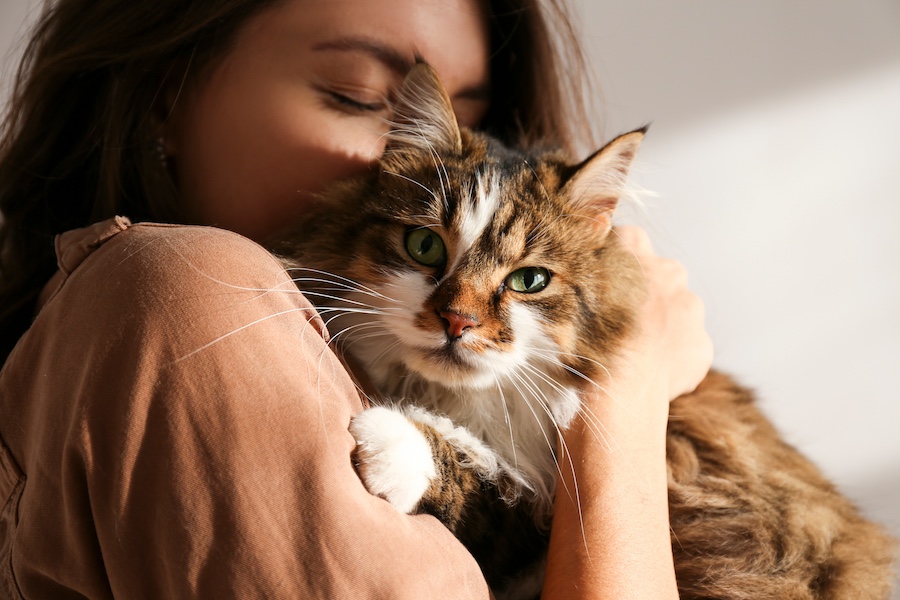
Do cats have feelings? The answer lies in the look of this cuddly feline.
Do cats have feelings?
Right now cat lovers will roll their eyes and say, “What kind of question is this? Of course cats have feelings! Otherwise, how do you explain those purrs, those licks on the forehead and those lingering looks?”
The answer, therefore, is yes: cats definitely have feelings and emotions.
They naturally experience the primary ones, defined by Darwin as joy, sadness, anger, fear, disgust and surprise, which are those that facilitate survival.
But they also feel other emotions, which we can define as secondary, above all empathy, or the ability to perfectly understand what emotions we humans are feeling at that given moment.
There are those who assign this ability to the magical nature of felines, but the research published in the Current Biology tells us that cats establish very close emotional bonds with the people they care about and, precisely on the basis of these bonds, they are able to interpret the emotions of others.
Expressions, however, must be obvious.
Anyone who has a cat and has experienced a moment of strong sadness or discouragement surely saw, at least once, his cat stealthily getting closer and approaching. This may be a sign that the cat needs to better understand what is happening, and then curl up next to the human and start purring.
As happens with all animals, in these cases a lot depends on the personality of the feline and on his level of socialization… or can we say, on his personality?
Yes, because we have seen that animals have feelings, which generate a real personality.
In this case, if the cat sees us suffering and approaches, first he wants to ‘see straight’ and then, after understanding that we are suffering, he’ll probably shows us his closeness, which is a real medicine for our hearts.
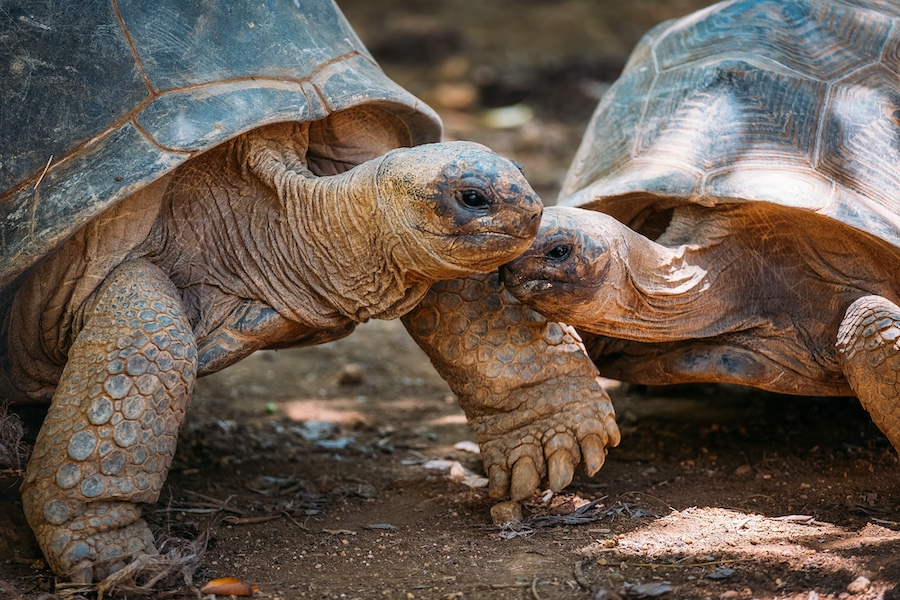
Maybe these two tortoises are kissing?
Do tortoises have feelings?
Tortoises may seem a little incomprehensible, but since we have defined that animals have feelings, even these extraordinary and long-lived creatures are not different.
According to a research published in the National Library of Medicine, there are numerous studies that state that reptiles know how to experience emotions and states such as anxiety, stress, excitement and even fear. In particular, the research focused on analyzing other studies carried out over time, confirms that tortoise and reptiles in general are subjected to strong emotional swings when they are in a state of captivity, for example in a pet shop.
How do they express their feelings? Some studies have found that tortoises increase their heart rate and this should be interpreted as a real emotional swing. Even when handled gently, tortoises and iguanas have in fact shown an increase in heart rate, which can be translated into an indicator of emotional stress.
This proves once again that animals have feelings, in this case primary ones such as fear.
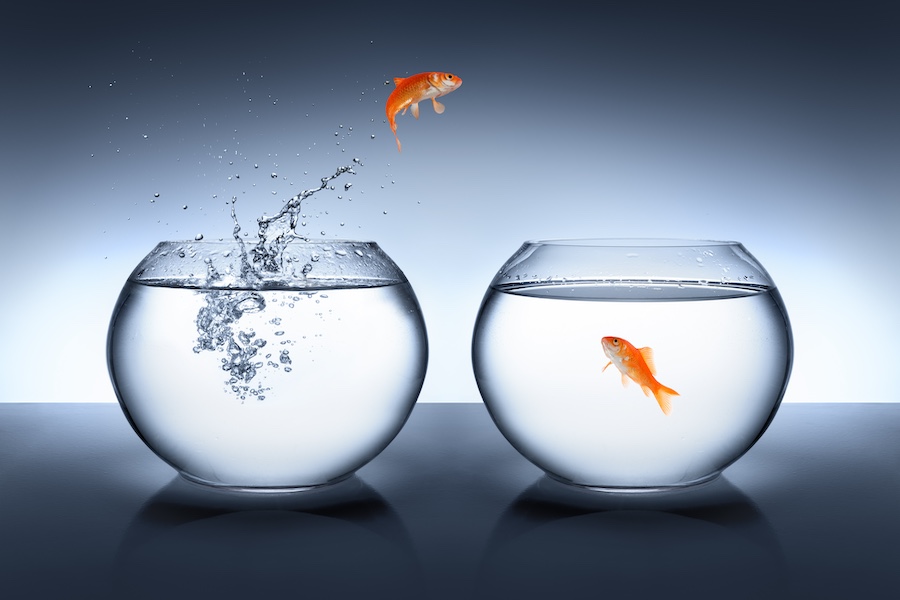
It seems this goldfish is in a hurry to reach his love.
Do fish have feelings?
Now there’s no doubt: animals have feelings. Anyway, for some species it is more difficult to recognize them. Fish are among these, because they inhabit an environment very different from ours with their own laws: their way of communicating is very different from that of other animals such as mammals.
Unfortunately, for a long time it was thought that fish did not have feelings, but over the years the scientific research (University of Calgary) has examined in depth this topic, and has now also demonstrated, the ability of fish to detect fear in their conspecifics and to experience fear as well.
This ability is regulated by oxytocin, one of the feel-good hormones that is the basis of empathy in humans too.
In the aquatic environment, one of the fish who most have emotions is the octopus.
After a long study, the University of San Francisco defined that despite being invertebrates, octopuses feel pain like mammals and have a complex emotional system.
These incredible animals have three hearts and are endowed with an exceptional intelligence, so that it may suggest us that they have feelings. However, the question is quite complex, because it is a matter of animal intelligence compared to human intelligence.
It’s quite common to hear stories of octopuses in captivity who manage to escape even from the strangest situations, thanks to their ability to tighten, to lift heavy weights and also to find a way out.
Octopuses certainly don’t like captivity.
According to an article in The London Review of Books, at the University of Otago, New Zealand, an octopus was released because he caused short circuits by spraying water against the light bulbs in the aquarium.
Could we reasonably say that the octopus was angry about his condition and reacted accordingly?
Science is cautious about this but, it is interesting to discover the story of cephalopod scholar Jean Boal. The researcher was giving a defrosted squid to an octopus, although it is not one of his favorite foods. Instead of eating it, the octopus wrapped his tentacle around it and, looking at Jean, threw the squid down the drain pipe.
At the basis of this behavior there is a remarkable intelligence, but from here to affirming that octopuses have feelings, there is still a long way to go. In any case they certainly are among the most special creatures in the world!

When dogs feel pain they show it in many ways, and their gaze is one of them.
Do animals feel pain?
What we’ve seen until now suggests that animals have feelings, including pain.
In fact, many people wonder if animals don’t feel pain, the answer is yes, they feel it and they express it in their own way.
We certainly know that if we act on the cause of their suffering, behavior can naturally improve.
It is up to humans to understand that animals are suffering and act accordingly, because they obviously cannot tell us if they have physical or emotional discomfort.
It is therefore necessary to observe them, improve empathy, spend time with them and analyze any behavioral anomalies, in order to be able to act and, if it is physical pain, ask your trusted vet for support to soothe the pain and try to solve the problem.
Emotional pain, on the other hand, is difficult to recognize, only by looking our four-legged heart with extreme sensitivity and empathy, we’ll be able to understand if he’s suffering.

What an irresistible laugh… how happy is this fur baby?
Animal feelings and evolution
Now that we have seen some studies regarding the matter that animals have feelings, it is interesting to define that what they feel, especially in the case of our pets, is still governed by a brain system different from that of human beings.
Emotions in animals are fundamental tools to ensure survival.
In humans this has been lost with evolution, while in animals it is essential for making the right decision at the right time, because it is useful to protect themselves, to form couple bonds, in short, to survive.
However, there is one last theme that deserves to be handled, because it is associated with the strongest of feelings, the one that can move the world and regulates everything: love.
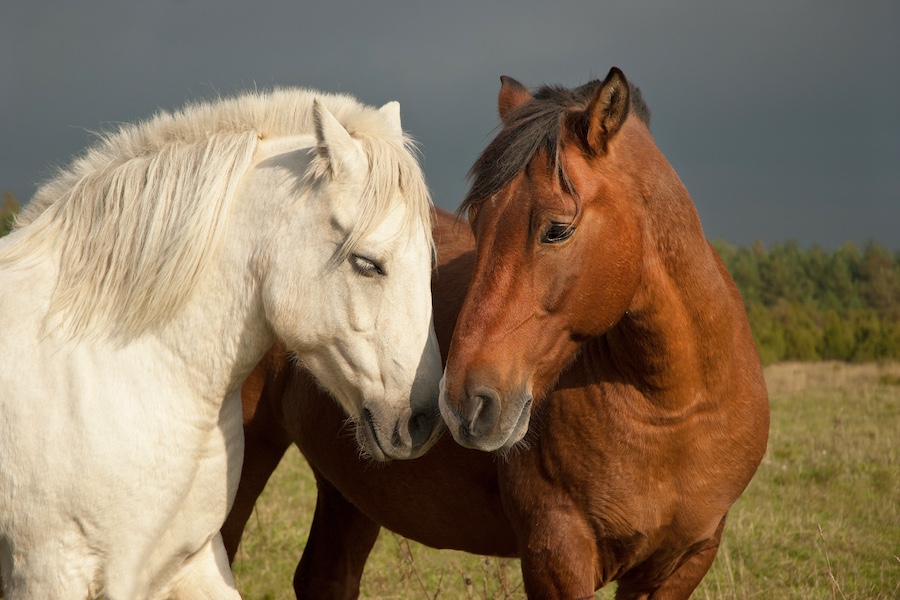
The way these two beautiful horses touch each other suggests a world of love.
Do animals fall in love?
We may think that animals mate only for reproductive purposes, but since animals have feelings, isn’t it reasonable to think that they fall in love as well?
As seen, it is always good to divide emotions and to understand them differently from those felt by us humans, because cognitive processes, those linked to knowledge, are different.
However, how many times have we seen dogs exchanging loving gestures even without purely reproductive purposes? And what about ducks and geese, or wolves, who can create strong couple bonds that last a lifetime?
Unlike primary emotions, such as fear which manifests itself clearly with evident behaviors such as face grimace, low ears or an escape, love is not an emotion that is so recognizable externally.
Love is an internal state and only those who experience it can attempt to explain it. In fact, it is true that not even humans are able to explain it!
If animals have such strong feelings that they stay together for years, this can probably be a form of love.
Just as what the fur baby feels towards us can be love, especially when we also show him that we feel the same.
Just think about the bond with your pet and the amount of time he sticks close to you!
We already know that animals have feelings and experience very complex emotions, and now we are certain of this thanks to science, even if deep down in our hearts we already knew it.
Why do we need this proof? To try to never make animals suffer, to help them feel better, and to try to understand them, respect them and love them as they deserve for all the great unconditional love they show us every day.
Article written with the consultancy of Chiara Festelli, Dog Trainer.







